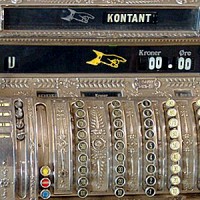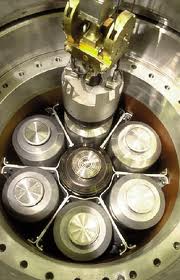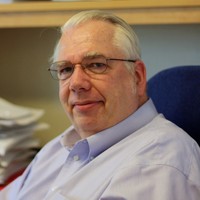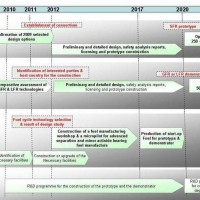MIT nuclear fuel expert has new economic ideas to deal with it
Colocating all back-end facilities will increase community acceptance because of job creation
A nationally recognized expert says that colocating a reprocessing plant with a waste disposal facility can improve the economics, efficiency, and public acceptance of both.
Charles Forsberg, executive director of the MIT Nuclear Fuel Cycle Study, writes in the November 2011 issue of the Amercian Nuclear Society's Nuclear News magazine that a new business model is needed to manage spent nuclear fuel and repositories for long-term storage of highly radioactive waste.
In an interview with Forsberg at the ANS Winter Meeting held in November in Washington, D.C., Forsberg said that there is an opportunity to borrow from the business model of an airport authority. For instance, an airport authority owns the runways, and colocated with them are public and private airline terminals and freight handling warehouses. All of these facilities, which generate user fees for the airport authority, benefit from colocation with the high-value runways.
The issue related to spent fuel, Forsberg said, is whether the Secretary of Energy's Blue Ribbon Commission asked the right questions. A key issue is how to make a spent fuel repository, and colocated reprocessing center, an attractive economic asset for a community that hosts them. Such a strategy would also save 30 percent of the costs of building the plants at separate locations, according to Forsberg.
 By harnessing the idea of an airport authority to the concept of a federal off-the-books corporation to manage spent fuel, Forsberg said that he sees a path forward that benefits the nuclear industry and local communities.
By harnessing the idea of an airport authority to the concept of a federal off-the-books corporation to manage spent fuel, Forsberg said that he sees a path forward that benefits the nuclear industry and local communities.
Forsberg pointed out that spent fuel is a very valuable material because of the energy value inside it. He suggested that the way to get states to accept a colocated repository, interim storage, and a spent fuel reprocessing facility is for the federal government to offer two huge economic incentives.
Revenue and jobs for states
The first incentive is to allow states to reap some of the revenues from sales of the reprocessed spent fuel. The second is to offer the state that accepts such colocated facilities the opportunity to reap a huge benefit from hundreds of jobs at these sites and the resulting payroll taxes. Forsberg said that state governors readily understand the airport authority business model and could use it to accept a spent fuel repository and reprocessing center.
 The airport authority would be the economic development mechanism a state would put in place to manage its role relative to the facility. Facilities on-site would be tenants and could include privately operated fuel reprocessing centers to handle low-enriched uranium or government/defense plants to downblend high-enriched uranium from naval nuclear reactors. Presumably, the tenants would be responsible for environmental protection and safety of operations at these facilities.
The airport authority would be the economic development mechanism a state would put in place to manage its role relative to the facility. Facilities on-site would be tenants and could include privately operated fuel reprocessing centers to handle low-enriched uranium or government/defense plants to downblend high-enriched uranium from naval nuclear reactors. Presumably, the tenants would be responsible for environmental protection and safety of operations at these facilities.
The key to this business model is that a repository has an interim storage capability that makes it possible to retrieve the spent fuel when facilities are ready to reprocess it. Forsberg pointed out that public opinion strongly supports holding open the option of reprocessing spent fuel and not simply burying it in the ground as part of a once-through cycle.
Is spent fuel a waste or a resource?
 One finding of the Massachusetts Institute of Technology study is that light water reactor spent nuclear fuel is not yet formally defined as a waste or a resource. Forsberg noted that as a resource it will enable the development of fast reactors, which use uranium 20 to 50 times more efficiently than LWRs. Regardless of whether a plant is reprocessing LWR or fast reactor spent fuel assemblies, a repository will be needed for residuals from the process.
One finding of the Massachusetts Institute of Technology study is that light water reactor spent nuclear fuel is not yet formally defined as a waste or a resource. Forsberg noted that as a resource it will enable the development of fast reactors, which use uranium 20 to 50 times more efficiently than LWRs. Regardless of whether a plant is reprocessing LWR or fast reactor spent fuel assemblies, a repository will be needed for residuals from the process.
Forsberg's enthusiasm isn't shared by the government. The Blue Ribbon Commission said in its draft report that it didn't see a near-term opportunity for reprocessing spent nuclear fuel. It wrote that it could be decades or longer for technologies to develop what would "fundamentally alter the waste management challenge." This is why, Forsberg said, any fuel put into a repository must be retrievable to preserve options for the future to reprocess it and reap the resulting economic benefits.
GAO study on nuclear fuel cycle options
The U.S. General Accountability Office agrees that it may be some time before anyone decides on the technologies that are best, in terms of economics and efficiency, to reprocess spent fuel in the United States. According to an October report (GAO-12-70), the Department of Energy's R&D plan has not yet explained the readiness of technologies to answer this question. Further, the GAO noted that the DOE has not yet established the necessary collaborative agreements to carry out this work.
The GAO's main complaints are that while the DOE has cataloged the technologies, it doesn't have a preferred choice, nor has it identified gaps in technology development or roadmaps to close them.
The GAO recommended that the DOE revise its R&D plan to include collaboration with the National Nuclear Security Administration, the nuclear industry, and international entities to identify those technologies that are ready to reprocess spent nuclear fuel in the United States or how much more R&D work is needed to get them to that point.
Upcoming deficit reduction plans for the federal government may mean it will take longer for the DOE to address the issue. A November 15 report by the DOE's Inspector General predicted that deep cuts in the agency's funding by Congress could significantly set back many energy-related R&D programs.
European Commission nuclear fuel/fast reactor roadmap
An industrial initiative by the European Commission has produced a roadmap involving reprocessing of spent fuel and development of fast reactors.
The goal is to achieve a vast increase in the sustainability of nuclear energy. This outcome would be achieved through demonstrating the technical, industrial, and economic viability of Generation-IV fast neutron reactors (FNRs). (large roadmap image)
It would demonstrate that nuclear energy can remain a long-term contributor to the low carbon economy and building on the safety, reliability, and competitiveness of current reactors.
The objective is to enable the commercial deployment of Generation-IV FNRs by 2040. In the meantime, the plan is to maintain at least a 30-percent share of EU electricity from currently available reactors with an expansion toward the cogeneration of process heat for industrial applications when such markets develop.
Japan reaffirms commitment to spent fuel reprocessing
At a November 25 press conference, Makoto Yagi, president of Kansai Electric Power and chairman of the Federation of Electric Power Companies of Japan (FEPC), said that the group will "make unremitting efforts to promote the establishment of the nuclear fuel cycle."
He said that it was irrational to discard such a valuable resource as nuclear fuel. He added that the government should reconsider its plans to terminate the Monju fast breeder reactor project, and said that such a decision would have a "grave impact" on the FBR fuel cycle.
Yagi also noted that direct disposal of spent fuel would require more land than the reprocessing approach. Japan has no high level waste repository to support direct disposal of spent nuclear fuel.
----
Dan Yurman publishes Idaho Samizdat, a blog about nuclear energy, and is a frequent contributor to ANS Nuclear Cafe










